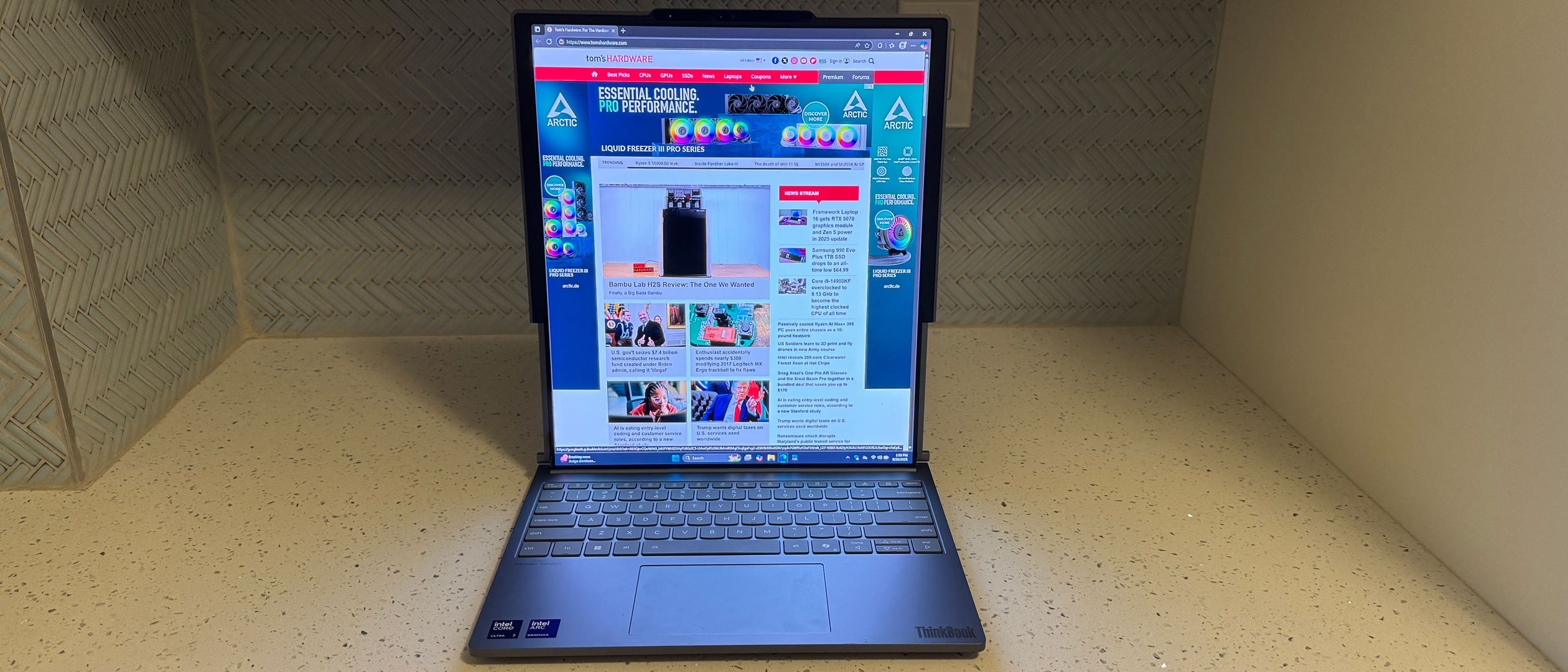*
*Lenovo ThinkBook Plus Gen 6 Rollable – A Quick Take**
The ThinkBook Plus Gen 6 rolls out a 14‑inch screen that can unfurl into a 16‑inch display, a feature that makes it a standout in the ultrabook market. Lenovo has spared no expense on the keyboard, trackpad, and speakers, but the hefty price tag and a handful of first‑generation quirks mean it’s aimed at hardcore enthusiasts rather than the average buyer.
---
### Design & Build
At first glance the laptop looks like a typical silver clamshell. The chassis is aluminum, the keyboard is backlit, and the power button doubles as a fingerprint reader. The main drawback is the bezel: wider on the sides than on the top and bottom, giving it a slightly awkward look. The left side hosts the only three ports – two Thunderbolt 4/USB‑C and a 3.5 mm headphone jack – a minimal selection that reflects the space taken up by the rollable display.
Dimensions are 11.95 × 9.08 × 0.78 inches, and the weight is 3.72 lb (1.69 kg). The 65 W GaN charger comes with a detachable USB‑C cable, a nice touch that Lenovo should adopt more widely.
---
### Display
* **Rolled:** 14‑inch, 2000 × 1600, 5:4 aspect ratio, 120 Hz POLED (plastic OLED).
* **Unrolled:** 16.7‑inch, 2000 × 2350, 8:9 aspect ratio, 120 Hz POLED.
The motor that rolls the screen takes about 9 seconds to fully extend or retract. Lenovo claims 30 000 hinge cycles and 20 000 roll cycles, a figure that is reassuring but largely irrelevant for everyday use.
The panel covers 150 % of DCI‑P3 and 211 % of sRGB, outpacing many dual‑screen competitors. However, brightness tops out at 381 nits, which is lower than the Yoga Book 9i Gen 10 and the MacBook Pro. The screen is not touch‑enabled, and the hinge only allows a maximum of ~90° angle, limiting couch‑side use. The display also shows a visible crease at certain angles, a minor aesthetic flaw.
The unrolled mode is ideal for multitasking: split‑screen productivity, vertical coding, or watching games that fit the tall aspect ratio. It’s not a gaming device; the integrated Intel Arc 140 V GPU and lack of a dedicated GPU mean many titles will cut off or underperform.
---
### Performance
The only configuration ships with an Intel Core Ultra 7 258V, 32 GB LPDDR5x‑8533 RAM, and a 1 TB PCIe M.2 SSD. Benchmarks:
* **Geekbench 6:** 2,694 single‑core, 10,847 multi‑core (lowest among comparable laptops).
* **Cinebench 2024:** Stable scores in the high 490s; CPU cores average 2.62 GHz (P‑cores) and 2.99 GHz (E‑cores).
* **File copy:** 1,075 MB/s, comparable to the Yoga Book.
* **4K to 1080p transcoding:** 7 min 13 s, slower than the HP OmniBook X Flip 14 and Apple’s M4.
The machine handles everyday productivity—writing, spreadsheets, video calls, light coding—without issue. For demanding workloads or gaming, the integrated graphics and older CPU architecture are limiting.
---
### Keyboard & Touchpad
The scalloped keys feel solid and allow a comfortable typing speed of ~110 WPM with a 2 % error rate. The touchpad is responsive and supports multi‑gesture input, but no additional moving parts are needed for the rollable screen.
---
### Audio
Despite its slim profile, the laptop delivers surprisingly robust speakers. In a test with Linkin Park’s “Two Faced,” vocals and drums were clear, though bass was modest. Switching to Dolby Access’s “balanced” mode improved low‑end response.
---
### Battery Life
* **Rolled (14‑inch):** 9 h 28 min (web browsing, light WebGL, 150 nits).
* **Unrolled (16‑inch):** 8 h 43 min.
Both figures exceed the Yoga Book 9i Gen 10 and the HP OmniBook X Flip 14 but lag far behind Apple’s M4‑powered MacBook Pro, which clocks in at 18 h 31 min. Heat measurements during Cinebench stress: keyboard 98 °F, touchpad 92.3 °F, bottom vent 113.5 °F; CPU average 70 °C.
---
### Webcam & Camera Features
A 5 MP camera with infrared and a time‑of‑flight sensor sits on the lid. Video quality is acceptable but grainy at high resolution. The camera’s shutter switch is on the camera bump; a keyboard button would be preferable.
---
### Software & Warranty
Lenovo bundles several utilities:
* **ThinkBook Workspace:** Adds mini‑apps (reminders, calendar, clipboard manager) and a secondary virtual display. It can be disabled from launching on screen roll.
* **Lenovo AI Now:** Local AI document processing, but requires an account.
* **Vantage:** Warranty, system updates, battery info, and a McAfee VPN ad.
* **Smart Meeting & Smart Connect:** Camera adjustments and device pairing.
The software suite is feature‑rich but can feel intrusive, especially for a $3,300 machine. Lenovo offers a one‑year courier or in‑store warranty, extendable for additional coverage.
---
### Bottom Line
The ThinkBook Plus Gen 6 Rollable turns a futuristic concept into a tangible product. Its rollable POLED display, solid build, and decent performance make it a compelling choice for power users who value screen real estate and are willing to pay a premium. The lack of touch, limited ports, and high price are significant trade‑offs. For most users, a conventional ultrabook plus a portable monitor would deliver similar functionality for less money. If the unique rolling screen and the engineering behind it justify the cost for you, the ThinkBook Plus Gen 6 Rollable is worth a closer look.













